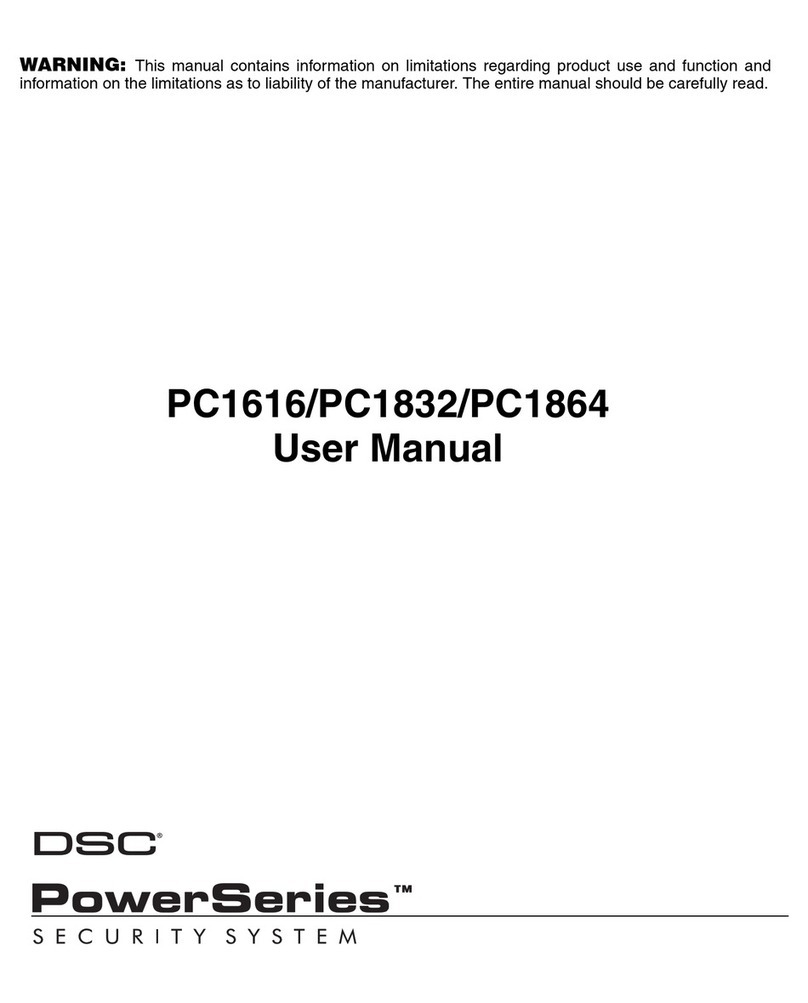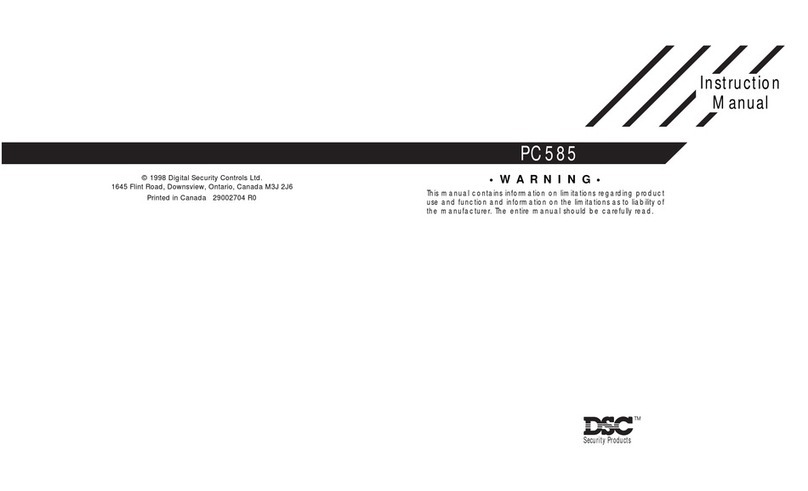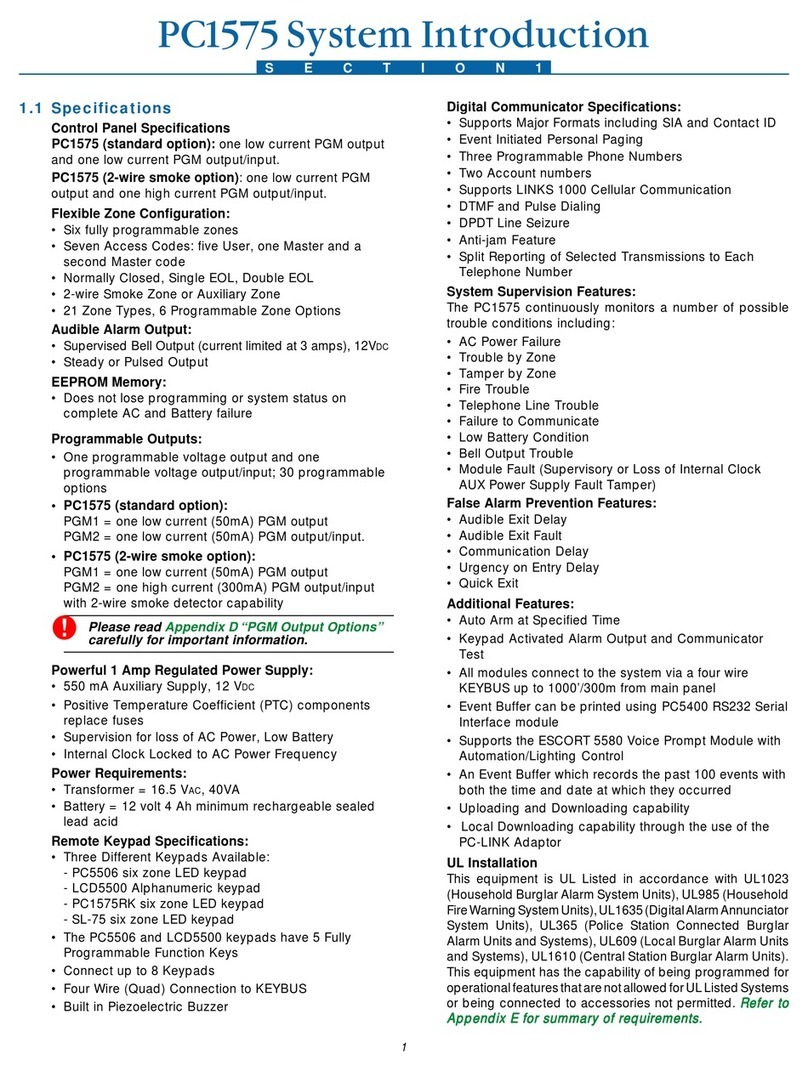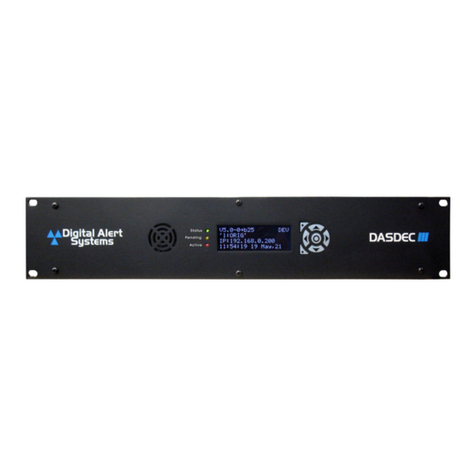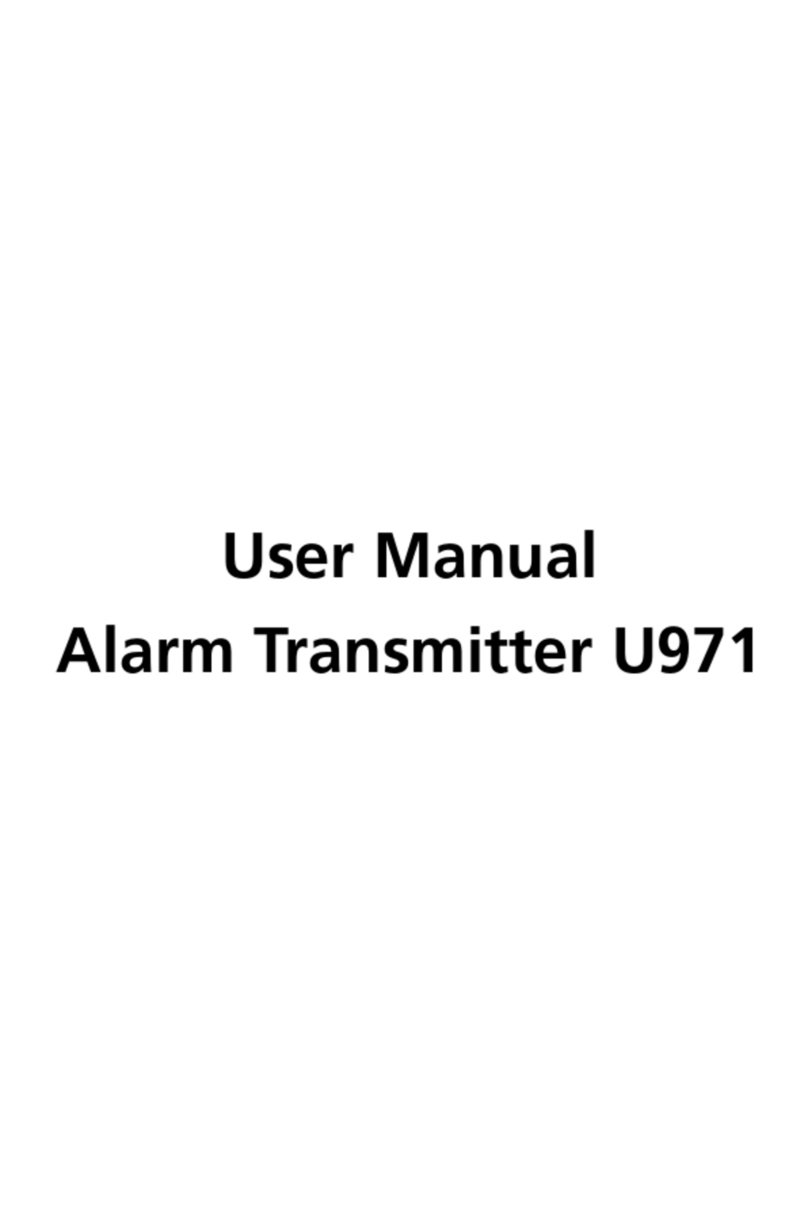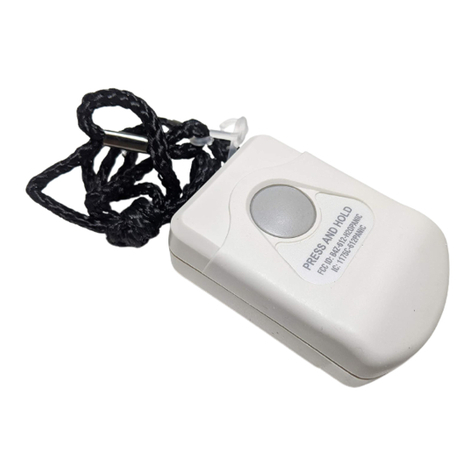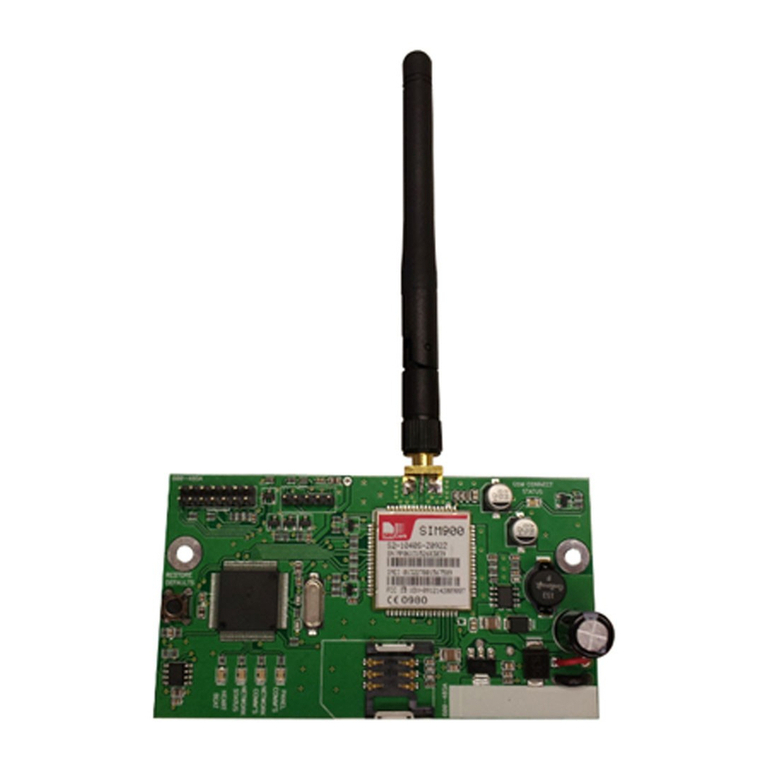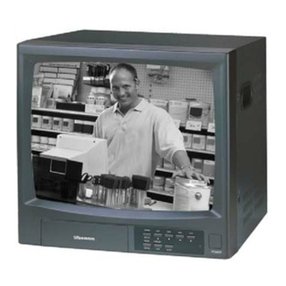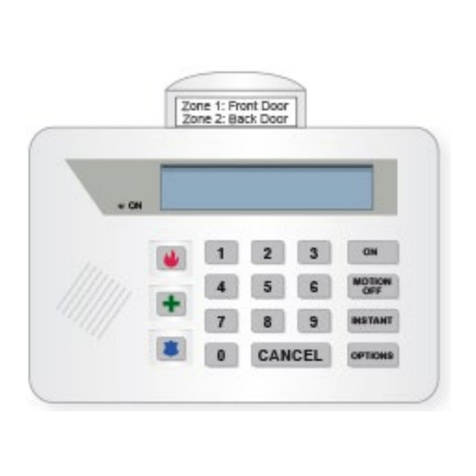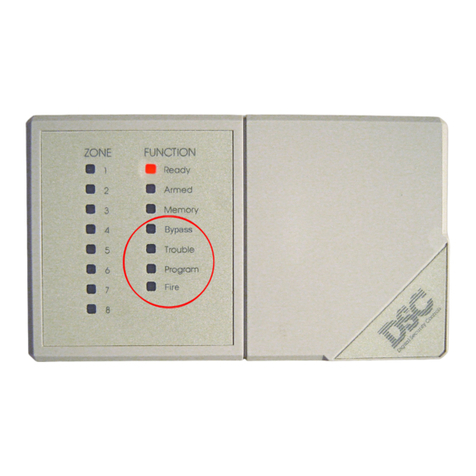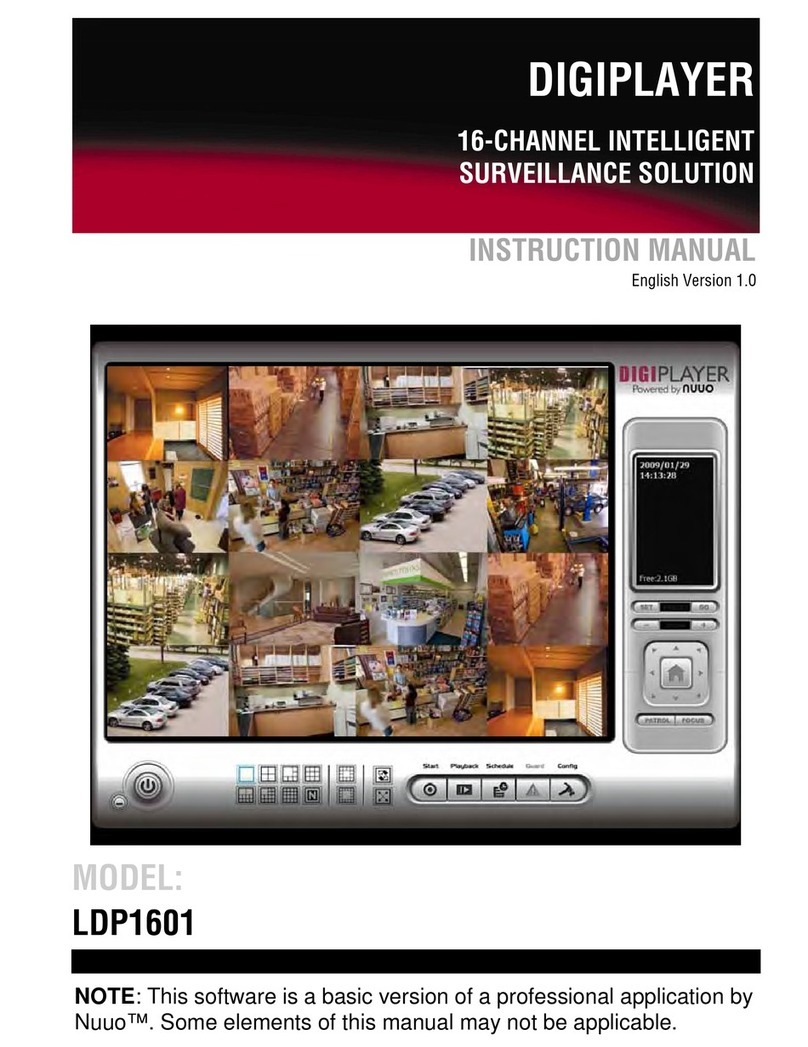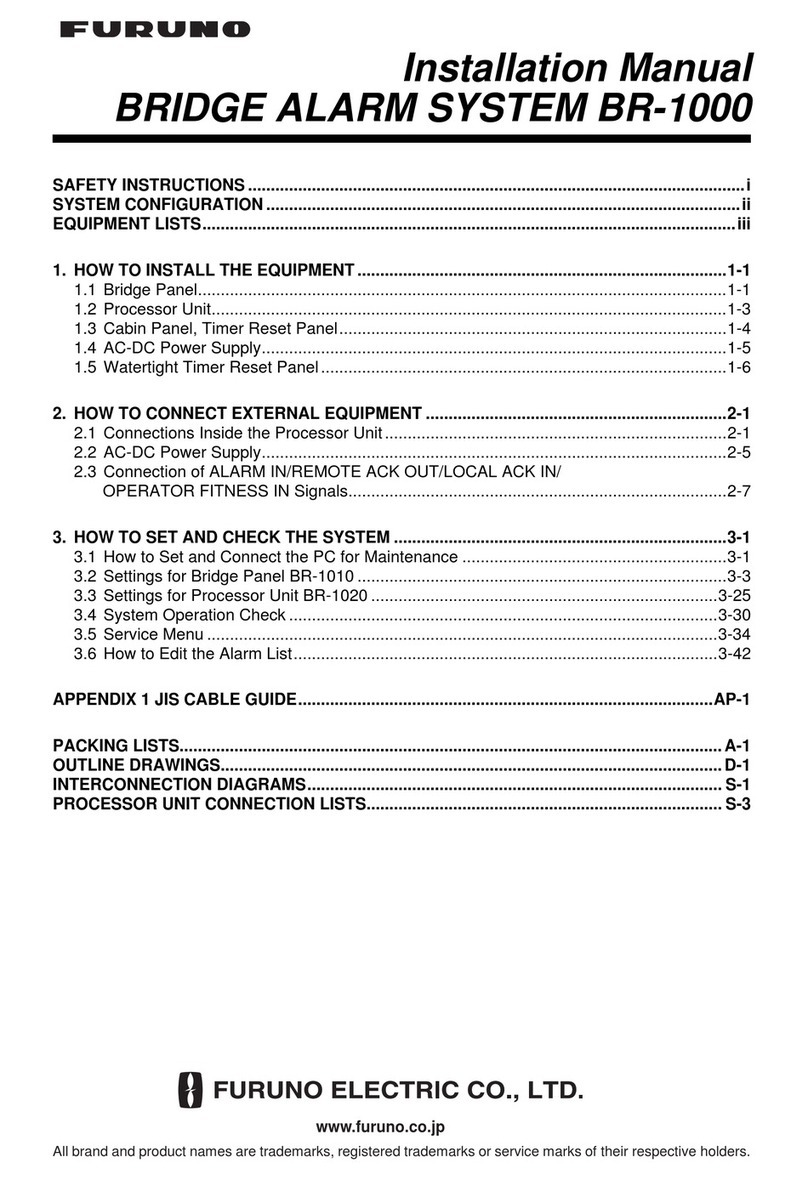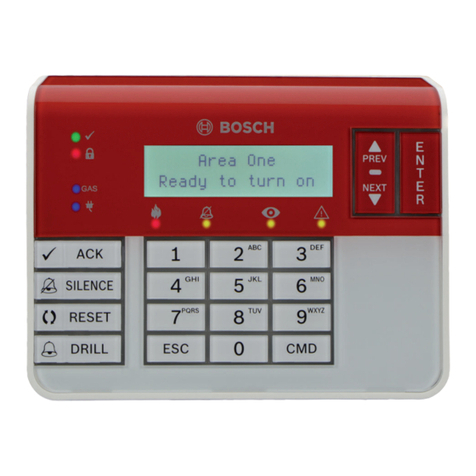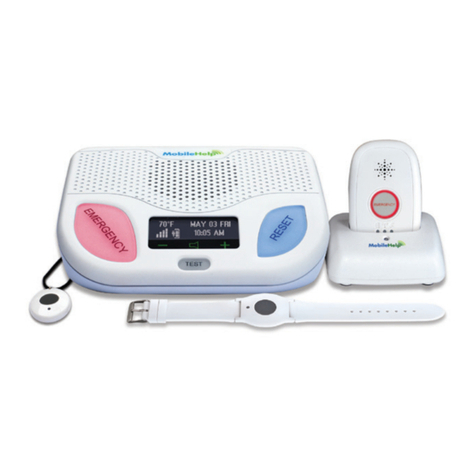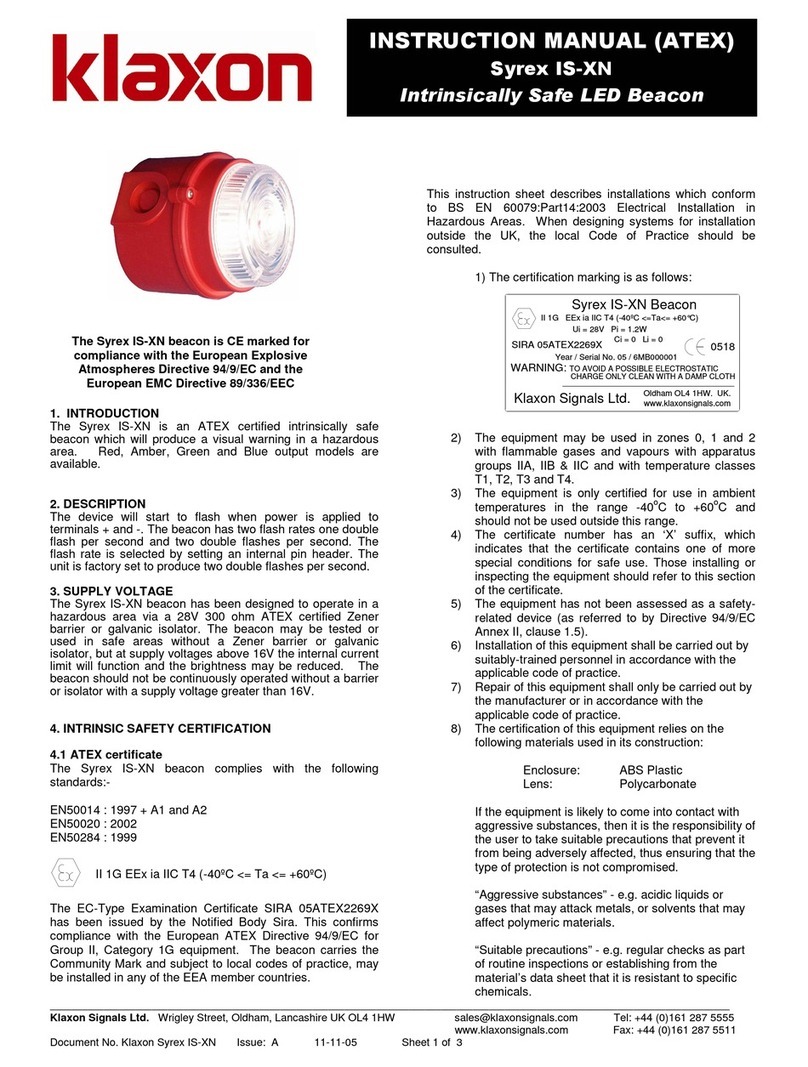Digital Security Controls WLS9000 User manual

WLS9000
Integral Wireless Alarm System
DRAFT Manual
Revision 0.01 – Sept 30th, 1999
WARNING: THIS DOCUMENT IS THE PRIVATE
PROPERTY OF DIGITAL SECURITY CONTROLS LTD.
IT CONTAINS CONFIDENTIAL INFORMATION AND IS
NOT TO BE COPIED OR DISTRIBUTED.

Digital Security Controls Ltd. 2Private and Confidential
Installation Manual DATE : 09/30/97 DRAFT
Table of Contents
1.0 INTRODUCTION.............................................................................................................................................................4
1.1 PRODUCT INTENTIONS .....................................................................................................................................................................4
4.1 HARDWARE DESCRIPTION................................................................................................................................................................5
4.2 WLS9000 Main Controller..........................................................................................................................................................5
4.3 Spread Spectrum Wireless...........................................................................................................................................................5
4.4 Voice Prompting Components.....................................................................................................................................................5
4.5 Speaker Control ..........................................................................................................................................................................5
4.6 Piezo............................................................................................................................................................................................5
4.1.10 Remote Sounder ......................................................................................................................................................................5
4.1.11 Microphone for Central Station Talk/Listen ...........................................................................................................................6
4.1 Terminal/Jack Connections.........................................................................................................................................................6
4.4 MISCELLANEOUS .............................................................................................................................................................................6
4.3 PLASTICS .........................................................................................................................................................................................6
5.0 DETAILED DESCRIPTION OF SOFTWARE FEATURE SET.......................................................................................7
5.2.1 New Function Key Types.........................................................................................................................................................7
5.2.2 Installer Programming ‘Wizard’.............................................................................................................................................8
5.2.2.1 Serial Number Programming................................................................................................................................................................... 8
5.2.2.2 Zone Label Programming........................................................................................................................................................................ 8
5.2.2.3 Communications Programming............................................................................................................................................................... 9
5.2.2.4 Module Placement Test........................................................................................................................................................................... 9
5.2.3 Internal or External Annunciation Selection...........................................................................................................................9
5.2.4 Voice Prompting......................................................................................................................................................................9
5.2.5 Volume of Annunciation..........................................................................................................................................................9
5.2.7 Verbal Chime ........................................................................................................................................................................10
5.2.8 Verbal Alarm.........................................................................................................................................................................10
5.2.9 Function Keys While in Installer’s Programming.................................................................................................................11
5.2.10 Memo Feature.......................................................................................................................................................................11
5.2.11 Recording of Custom Labels.................................................................................................................................................11
5.2.13 Function Key Programming in ESCORT Programming.......................................................................................................12
5.2.14 New Logs...............................................................................................................................................................................12
8.0 FUNCTIONAL DESCRIPTION OF….........................................................................................................................12
8.1 STANDARD FEATURES....................................................................................................................................................................12
8.2 FEATURE SET.................................................................................................................................................................................13
8.2.1 Zone Definitions [001]-[004] ...............................................................................................................................................14
8.2.2 System Times [005]...............................................................................................................................................................15
8.2.3 Special Access Codes [006]-[008]........................................................................................................................................16
8.2.4 Keypad Lockout Options [012].............................................................................................................................................16
8.2.5 System Options Codes...........................................................................................................................................................16
8.2.6 Hardwired Zone Assignment [804] Subsections [71] and [72]............................................................................................21
8.2.7 Remote/Local Annunciation Options (Section [017] Options 4 and 5).................................................................................21
8.2.8 Zone Attributes [101]-[132] .................................................................................................................................................21
8.2.9 Telephone Numbers......................................................................................................................................................................23
8.2.10 Reporting Codes.........................................................................................................................................................................23
8.2.11 Communicator Format Options [360].......................................................................................................................................26
8.2.12 Communicator Call Directions [361]-[368]..............................................................................................................................30
8.2.13 Communication Variables [370]................................................................................................................................................31
8.2.14 Communicator Option Codes.....................................................................................................................................................32
8.2.15 Downloading Options ................................................................................................................................................................34

Digital Security Controls Ltd. 3Private and Confidential
Installation Manual DATE : 09/30/97 DRAFT
8.2.16 International Programming Sections.........................................................................................................................................36
[807] ESCORT Programming.........................................................................................................................................................39
[000] Function Key Programming........................................................................................................................................................39
8.2.17 Special Installer Functions.........................................................................................................................................................41
.4 USER “STAR” FUNCTIONS..................................................................................................................................................................42
9.0 DOWNLOADING SUPPORT.....................................................................................................................................48
9.1 Downloading Software Version Support...................................................................................................................................48
9.2 New Product Support and Structure .........................................................................................................................................48
9.3 PC-LINK Support......................................................................................................................................................................48
9.4 New DLS Identifier....................................................................................................................................................................48
10.0 PROGRAMMING WORKSHEETS ............................................................................................................................49
15.0 DOCUMENT REVISION ENDNOTES........................................................................................................................75

Digital Security Controls Ltd. 4Private and Confidential
Installation Manual DATE : 09/30/97 DRAFT
1.0 Introduction
1.1 Product Intentions
The WLS9000 is an integrated wall or desk mounted security system. This panel is designed to conserve time in its
installation, but yet retain a large variety of user-friendly features found in our modular systems. The WLS9000
incorporates a number of features not available in other DSC products, especially those that are intended to
decrease installation time and increase end user friendliness. The WLS9000 is available in both wallmount and
deskmount configurations, both of which will have wireless receiver and voice prompting capabilities.
The WLS9000 is a power platform that has been packaged into one stylish controller unit.
•Alarm Panel and Communicator
•Wireless Receiver capabilities
•Voice Prompt Navigation System
•Voice Prompt User Interface with Help and Status
•Piezo Alarm to Annunciate Alarm Conditions
•Eight Programmable Function Keys
•Hardwired Remote Sounder Support
•32 Wireless Zone Support
Included in this kit
•Two WLS915 Door/Window contacts
•One WLS904 PIR motion detector
•One AC wall adapter
•One battery for 24 hour backup
•Hardware Package, i.e. wall mounting screws
•And one set of manuals
Other Supported system Components
The WLS9000 supports 32 wireless zones and other DSC wireless peripherals and devices including:
WLS 904 Wireless Passive Infrared Detector (PIR)
WLS 906 Wireless Photoelectric Smoke Detector
WLS 907 Wireless Slimline Universal Transmitter
WLS 908 Wireless Panic Pendant
WLS 909 Wireless Key FOB
WLS 910 Wireless Handheld Keypad
WLS 912 Wireless Glassbreak Detector (future release)
WLS 914 Wireless Pet Immune PIR Motion (future release)
WLS 915 Wireless Mini Slimline Transmitter (future release)
WLS 917 Wireless Drill Mount Universal Transmitter (future release)
Remote Sounder
Accessory Hardwired Remote Sounder for use with the WLS9000 (future release)

Digital Security Controls Ltd. 5Private and Confidential
Installation Manual DATE : 09/30/97 DRAFT
4.1 Hardware Description
4.2 WLS9000 Main Controller
The WLS9000’s main controller retains many aspects of the most current “Power Family” hardware platforms.
Changes include:
•Main Processor utilizes a PLCC C63 to conserve space and assembly
•Siren and Piezo control via RF Slave
•RF “Master” function handler. This eliminates one micro from the product.
•Internal ‘Keybus’ for communication to ESCORT micro, and nibble bus (four lines) to RF Slave.
•Remote Sounder Control
•‘Sleep’ command that turns off main power to all sections with the exception of the RF Slave. This is to conserve
power during loss of AC. The time is passed to the RF slave before sleep.
•All Talk/Listen Audio control
4.3 Spread Spectrum Wireless
The WLS9000 will have the equivalent of the following built-in:
•PC5132 Receiver
The ‘RF’ Section does the following:
•Control of Piezo sweep via local Blue Lite’s Telout.
•Monitoring of the two hardwired zone loops.
•Phone Line Energy Detect.
•Time Keeping in Sleep Mode.
4.4 Voice Prompting Components
The WLS9000 contains the equivalent of an ESCORT on the daughterboard . The ESCORT section controls the
following aspects of the WLS9000 product:
•All voice prompting
•Keypad Scanning
•Status LED Control
4.5 Speaker Control
The WLS9000 has an on-board speaker that is used for the annunciation of the voice prompts. There is a
function key that provides volume control of these prompts. This functionality is handled by the Main
Controller.
4.6 Piezo
The WLS9000 has an on-board 95dB piezo that is used to annunciate all audible alarm conditions that occur on
the system. This is controlled by the Main Controller processor.
4.1.10 Remote Sounder
The WLS9000 has an optional hardwired remote sounder accessory that may be used with the on-board siren or on
its own. This sounder is connected via a four wire interface and requires software for supervision and annunciation
control. It comprises of:
•High Volume Piezo (similar to the WLS9000 main unit)
•Low Volume Piezo
•Microphone
•Speaker

Digital Security Controls Ltd. 6Private and Confidential
Installation Manual DATE : 09/30/97 DRAFT
•Microcontroller for annunciation control and interface to the WLS9000.
This siren may be used for:
•High Volume Siren via Piezo (for Alarm Annunciation)
•Entry/Exit Delay Beeps (like the WLS-903)
•Central Station Talk/Listen (via mic and speaker)
•All Audio Annunciation.
There are four terminals used for the Remote Siren. They are:
•Vcc (Red)
•Ground (Black)
•Audio Carrier (Yellow)
•Data Line (Green)
4.1.11 Microphone for Central Station Talk/Listen
A microphone on the WLS9000 is used in conjunction with the on-board speaker for
Central Station Talk/Listen.
4.1 Terminal/Jack Connections
The WLS9000 has the following terminal connections:
•Four terminals for the Remote Sounder = This interface will use a four wire connection.
•Two terminals for AC Power – A 9V (@ 20VA) transformer is used as the source of AC at these terminals.
•Double Battery Leads for wiring the batteries in parallel.
•Two terminals for two Hardwired (EOL) Zone Loops. The common is shared with the Remote Sounder Interface.
•PC-LINK Header for Local Downloading
Four Terminals for the Telco Interface (Tip/Ring/T1/R1)
4.4 Miscellaneous
The WLS9000 is shipped with a removable overlay to assist the installer through the installation
process. This overlay outlines the following aspects of WLS9000 Programming and Installation:
•The Wizard’s “Yes” and “No” Programming Methodology.
•Function Key 1-6’s Hexadecimal Capabilities.
•Function Key 7’s “Backward” Function.
•Function Key 8’s “Forward” Function.
•Accessing the configuration wizard.
•Hardwired Zone Configuration.
4.3 Plastics
The WLS9000 requires all new plastics. The complete WLS9000 project comprises of the following plastics parts:
•Front Housing (08-843)
•Rear Housing w/Made in Canada (08-844)
•Rear Housing without Made in Canada – used Internationally where required (08-845)
•Wall Mount Backplate (08-846)
•Front Bezel (08-847)
•Front Bezel Sound Deflector (08-1056)
•LED Pipe (08-848)
•Rear Housing w/Made in Canada for Deskmount (08-926)
•Rear Housing without Made in Canada for Deskmount (08-927)
•Deskmount Interface Plate (08-1057)i

Digital Security Controls Ltd. 7Private and Confidential
Installation Manual DATE : 09/30/97 DRAFT
The WLS9000 will also use the Acuity Shroud (08-686) for supporting the microphone on the main unit.ii
The Remote Sounder will use the existing WLS902/911 Wireless Sounder plastics. They comprise of:
•RF Siren Case Front (08-166)
•RF Controller/Siren Strain Relief (08-223)
•RF Siren Jack Cover (08-225)
•RF Siren Wall Mounting Plate (08-643)
•Sounder Back Cover (08-746)
5.0 Detailed Description of Software Feature Set
5.2.1 New Function Key Types
The WLS9000 has the following new Function Key Types:
Status –The Status button on the WLS9000 may be pressed to annunciate the current status of the system. For
example:
“Zones are open. Zone 1. System is OFF. To turn ON, enter your access code. For
more options, press star.”iii
Pressing this key will internally create a link between the panel, ESCORT5580, and audio portions
of the WLS9000. When voice help is active, the keypad may be used to change status or program any
function of the system. This new key is programmable on WLSKeys to allow wireless initiation of Status.
Status is function key definition [27], and will use Mode Request %1C.
Volume Control – A new function key has been created to allow easy volume control of the voice prompts. When
this function key is pressed for two seconds, the WLS9000 will increment through the four different volume
levels from lowest to highest, cycling back to the lowest after the highest volume is reached.
For example, if the Volume key is pressed for two seconds, and the current Volume is Medium, the
WLS9000 will prompt:
“Volume is High.”
…at the new volume. If the key is held for another two seconds, the WLS9000 will state:
“Volume is Highest.”
…and so on.iv This Function Key is Type [28], and uses Mode Request %1D.
Note: this function key only controls the volume of the main WLS9000 unit. Volume for the ESCORT
prompts heard via the phone line are still handled in [*][6].
Memo Record – When pressed, this function key will initiate recording (via the local microphone) of a message.
Recording begins after the three acknowledgement tones are annunciated. The recording can also be ended
by pressing this same function key. This Function Key is Type [29], and uses Mode Request %1E.
Memo Playback – When pressed, this function key will annunciate the recorded message. If there is no message

Digital Security Controls Ltd. 8Private and Confidential
Installation Manual DATE : 09/30/97 DRAFT
recorded, an error tone will be heard. This Function Key is Type [30], and uses Mode Request %1F.
5.2.2 Installer Programming ‘Wizard’
In order to facilitate an easy method to program the WLS9000, a Front End Installer’s Programming Wizard is
implemented into the WLS9000.
The Wizard is designed to:
•Accommodate the requirements of the mass marketer (i.e. 4-10 devices per system)
•Reduce installation time, even for those who may not be familiar with the DSC line of Products.
•Reduce the possibility of Programming errors.
•Provide easy RF and Hardwired Zone enrollment and placement.
5.2.2.1 Serial Number Programming
Once Installer’s Programming is successfully entered, and the Wizard selection is made, the Installer will be
prompted to enter the Serial Number of their first device. After the number is confirmed, the software will analyze the
number and make the following programming change based off of the Serial Number entered:
Transmitter Type Definition Other
2 (UTX) Define as Delay 1 (Type [01])
3 (Detector) Define as Interior Stay/Away (Type [05])
4 (Smoke) Define as Delayed 24 Hour Fire (Type [87])
5 (Panic Pendant) Define as 24 Hour Panic (Type [16]) Disable Zone Supervision (Section
[804])
Note: this chart is the Programming Actions found in the Wizard Flowchart provided by Marketing.
Hardwired Zone ‘Enrolling’ – The Wizard can also be used to enroll Hardwired zones. Serial Numbers X00001
and X00002 have been reserved for the two on-board zones.
When a zone is enrolled in the Wizard as one of these zones, the WLS9000 will automatically assign the next
available zone number and enter it in Section [020].
For example, if the Installer entered 200001 as the seventh zone, the WLS9000 will assign Zone 7 as being the
first Hardwired zone in Section [20] (first entry 07).
Note: Production must be advised to no longer use X00001 and X00002 as active serial numbers.
5.2.2.2 Zone Label Programming
If an enrolled device is a detector (i.e. not a WLSKey nor HHK), the Wizard will then prompt the Installer to enter
the Zone Label for the newly enrolled zone.
The WLS9000 has five presets for each type of detector programmed that may be selected via pressing the “A” to
“E” keys. Pressing the “F” key will allow the Installer to manually program the label from a chart found in the
manual.
The preset table is as follows:
Selection Type 2 (UTX) Type 3 (Detector) Type 4 (Smoke) Type 5 (Panic Pend)
“A” Preset Front Door Main Floor Motion Main Floor Fire No Presetsv
“B” Preset Back Door Upstairs Motion Upstairs Fire
“C” Preset Garage Door Downstairs Motion Downstairs Fire
“D” Preset Window Hallway Motion Hallway Fire
“E” Preset Patio Door Garage Motion Garage Fire
As soon as a Label is programmed (and confirmed) either via Preset or manual entry, it is immediately stored in
EEPROM.

Digital Security Controls Ltd. 9Private and Confidential
Installation Manual DATE : 09/30/97 DRAFT
5.2.2.3 Communications Programming
After all of the Serial Numbers have been entered, The Wizard will proceed into Communications Programming.
Here the Installer is prompted for the First Telephone Number and it’s corresponding Account Code. As with all
Wizard Programming, each data entry is followed by a confirmation routine to ensure the data is properly entered.
5.2.2.4 Module Placement Test
The Module Placement Test of the WLS9000 is quite different from previous Power-Based products as it
incorporated the following changes and enhancements:
•Each Detector Must pass three Consecutive Tests before being enabled on the system.
•Each Detector is enabled in Section [202]-[205] only after passing the three tests mentioned above. There is no
way to manually override this enrollment process.
•There are only “Good” and “Bad” Placements. “Fair” has been removed; it’s former status internal to the
software is considered a “Bad”.
•The piezo will squawk once for “Good” and three times for “Bad”.
•If the Placement is exited before all zones are properly enrolled, a General System Trouble is generated at the
keypad. This trouble can only be cleared by re-entering the Module Placement Test and testing the un-enrolled
devices.
•Zones can be disabled via Section [202]-[205], but they cannot be enabled.
When Module Placement Test is entered, the system will annunciate all of the zones which have been enrolled on
the system, but are not enabled in Sections [202]-[205]. This allows the Placement Test to be entered after
additional devices have been enrolled on the system without the hassle or re-testing ‘placed’ zones.
As each device receives three “Good” placements, it is removed from the annunciation list and it’s corresponding bit
in Section [202]-[205] is toggled to enable the zone on the system.
After all zones have passed the Module Placement Test, the Wizard will end and the Installer will find him/herself in
base Standard Programming, where he/she may do additional programming not covered by the Wizard. “#” may be
pressed to exit.
5.2.3 Internal or External Annunciation Selection
A method of selecting either the internal piezo/speaker or external remote sounder for the annunciation of
alarms and Audio has been implemented in the WLS9000. This feature is to deter thieves from “homing in” on the
source of the alarm and tampering with the WLS9000, thus resulting in a potential security breech.
The settings are as follows:
•Local Annunciation (main unit: Section [040] Option 1)
•Remote Annunciation (Remote Sounder: Section [040] Option 2)
•Both (Section [040] Options 1 and 2 ON)
This feature is found in Section [040], Options 1 and 2, with Option 1 defaulted ON and Option 2 defaulted OFF.
5.2.4 Voice Prompting
The WLS9000 will have a complete library of prompts similar to the ESCORT5580 to assist the user through various
functions of the system. This will also include Installer programming prompting similar to ESCORT programming in
the ESCORT5580.
5.2.5 Volume of Annunciation
There is several different levels of volume for the on-board piezos and speaker.
•Full Siren (siren; as loud as possible for alarm conditions)
•Full Voice (speaker; used to verbosely annunciate alarms. Always = highest speaker volume setting)
•Conversational Audio (speaker; Voice Prompted Help = four selectable levels)
•Low “Beeps” (small piezo; trouble conditions)
The volume of the voice prompts may be selected one of two ways:
•Using the Volume Function Key (Type [28]) to toggle through the different volume settings.

Digital Security Controls Ltd. 10 Private and Confidential
Installation Manual DATE : 09/30/97 DRAFT
•Within [*][6] User Programming under selection 7.
5.2.7 Verbal Chime
A feature has been added to the WLS9000 that allows Door Chime to annunciate the Zone that has been
violated/restored as opposed to a series of beeps.
If the Verbal Chime Feature is enabled, whenever a zone with the Chime attribute enabled is violated, a series of
beeps will sound and the WLS9000 will prompt:
“Zone X”
When the zone is restored, the WLS9000 will only sound a series of beeps similar to how Door Chime functions in
our current products.
If a label was programmed for the above Zone, the WLS9000 would annunciate (after the beeps):
“Back Porch Window”
…and so on.
If this option is disabled, only the series of beeps will be heard upon the violation and restore of zones that are
programmed to chime. If Chime is disabled via [*][4], no beeps nor prompts will be heard.
This option can be found in Section [017], Option 2, and is enabled (ON) at default.
5.2.8 Verbal Alarm
A feature has been added to the WLS9000 that provides verbal annunciation of alarm conditions on the system.
When an audible non-fire zone goes into alarm with this feature is enabled, the WLS9000 will sound the alarm
condition via the high volume piezo, but every 5 seconds (as programmed for Alarm Tone Period – Section [807],
Subsection [030])vi it will pause siren and the speaker an annunciate the alarm condition verbally:
“Alarm Zone 4”
or, if the label is programmed,
“Alarm South Bedroom Window”
When the zone is in alarm, the software automatically inserts the word “Alarm” in front of the appropriate zone label.
When an audible fire zone goes into alarm, the WLS9000 will sound the alarm condition via the high volume
piezo, but every 5 seconds (as programmed for Alarm Tone Period – Section [807], Subsection [030]) it
will pause siren and the speaker an annunciate the alarm condition verbally:
“Fire Alarm Zone 4”
or, if the label is programmed,
“Fire Alarm South Bedroom Smoke”
When the zone is in alarm, the WLS9000 automatically inserts the words “Fire” and “Alarm” in front of the
appropriate zone label.
In the case of multiple alarms, the WLS9000 will annunciate the first and latest zone that has gone into alarm.
Fire Zones will override Burglary Zones, similar as a Pulsing Bell will override a steady one.
This option can be found in Section [017], Option 3 and is enabled (ON) at default.
Notes: Fire annunciation always overrides any Burglary Zone alarm annunciation.
Verbal Alarm will cease with the Siren at Bell Time Out.

Digital Security Controls Ltd. 11 Private and Confidential
Installation Manual DATE : 09/30/97 DRAFT
5.2.9 Function Keys While in Installer’s Programming
In order to facilitate a more Installer-friendly user interface, the Eight Function Keys of the WLS9000 will perform
the following functions in Installer’s Programming:
Function
Key Number Default Function Key
Option Installer’s
Programming Function Used For:
1 Stay Hexadecimal ‘A’
2 Away Hexadecimal ‘B’
3 Chime Hexadecimal ‘C’
4 Exit Hexadecimal ‘D’
5 Status Hexadecimal ‘E’
6 Volume Hexadecimal ‘F’
Programming the
corresponding Hex Entry
for Account Codes,
Reporting Codes, Phone
Numbers, etc.
7 Memo Record Forward Moving ahead in the
Programming Wizard.
8 Memo Playback Back Moving backwards in the
Programming Wizard.
•Pressing any key that performs hexadecimal functions will generate a ‘Function Not Available” prompt if the
current section does not support Hex entries.
•The Forward and Back keys are used for:
1. Reviewing and editing previously entered data.
2. Advancing through sections to get to a certain Wizard Section.
Note: Only the Forward Key can be used outside of the Wizard.
5.2.10 Memo Feature
The WLS9000 will have a feature that allows the recording and playback of a verbal memorandum.
A user, while armed or disarmed, can record a memo via the “Memo Record” function key.
To record a memo, press and hold the Memo Record key for two seconds. After the acknowledgement beeps,
speak the desired message in the direction of the WLS9000. When finished, press the “Memo Record” function
key again (note: the two second debounce is not required here).
To hear the last memo recorded, press and hold the “Memo Playback” key for two seconds.
Note: Although the target record duration is 60 seconds, the exact numbers are under development by the
Software department.
5.2.11 Recording of Custom Labels
The WLS9000 has the capability of recording custom labels that may be assigned to a zone like any other
ESCORT Label. Labels [246] to [253] are reserved for Custom Labels 1-8.
These labels can be recorded via Installer’s Programming in Sections [701]-[708] using the following format:
When in Sections [701]-[708], the ‘Record’ key (Function Key 7) may be pressed to begin recording. After the
desired label is verbally annunciated by the Installer, ‘Playback’ (Function Key 8) may be pressed to end the
recording and annunciate the label. ‘Playback’ can be pressed again to re-annunciate the Label
recording.
Notes: Even if Function Keys 7 and 8 have been reprogrammed, they will still retain the same above functions in
these sections.
The quantities and length of the labels recorded will directly affect the total amount of time that a Memo
can be recorded. This is due to the fact as they share the same resources.

Digital Security Controls Ltd. 12 Private and Confidential
Installation Manual DATE : 09/30/97 DRAFT
5.2.13 Function Key Programming in ESCORT Programmingvii
Function Key programming has been moved out of the main panel and into Section [807], Sub-section [000]. This
has been done in order to keep the corresponding programming in the ESCORT section of the product. This
allows the desired functionality to be obtained without major impact to the existing architecture of the software.
5.2.14 New Logsviii
In order to support the new Module Placement functionality, a new log has been implemented for:
Event %1D5 Module Placement Test Unsuccessful
8.0 Functional Description of…
8.1 Standard Features
TWO MINUTE BYPASS ON POWER UP
When power is first applied to the system, all zones will be bypassed for two minutes. This is to allow time for the
devices to “settle” without causing false alarms. If after 2 minutes any zones are still unrestored, they will be
detected as open and will generate the respective alarm sequence, if applicable.
ALARMS ANNUCIATED WHILE ARMED
Zone Alarm conditions will be annunciated on all the WLS9000 by Verbally annunciating them as they occur.
This also occurs for 24 Hour alarms while disarmed.
ACCESS CODE REQUIRED TO CANCEL AUTO ARMING
An access code must be entered to cancel (postpone) the Auto-Arm sequence during the 1-minute Auto-Arm
Warning time.
HARDWIRED ZONE LOOP RESPONSE TIME
The hardwired zone loop response time is fixed at approximately 500ms.
Note: The WLS9000 hardwired zones require a single 5.6K EOL resistor.
TIME-OUTS
The general system time-out for Installers mode is 20 minutes. If the unit is left in Installer’s for twenty minutes
without a keypress, it will return to its base menu.
SILENT EXIT DELAY IF STAY ARMING
If the system Stay armed using any of the following methods, all audible exit features (keypad buzzer) that are
enabled will be silent for the exit delay time. Bell Squawk on Exit Delay will also be silent if Home or [*][9] Armed.
Bell Squawk on Arm/Disarm will still sound regardless of how the panel is armed/disarmed.
[*][9][Access Code]
[Stay Arm Function Key (Option 03)]
[No Entry Arm Function Key (Option 05)]
SPECIAL ENTRY IF ALARM IN MEMORY
If any entry delay begins on the system and there are alarms in memory, the entry tone shall sound a pulsing
tone for the entire entry delay (as per Entry Delay Urgency).
SWINGER SHUTDOWN RESET
If Swinger Shutdown is enabled on the system, all counters will be reset when the system time changes from
23:59 (11:59 PM) to 00:00 (12:00 AM) OR any time the system is armed (expiration of the exit delay).
ENTRY DELAY URGENCY

Digital Security Controls Ltd. 13 Private and Confidential
Installation Manual DATE : 09/30/97 DRAFT
The keypad will sound a steady tone during the Entry Delay. During the last 10 seconds of the Entry Delay, the
keypad buzzer will sound a pulsing tone (3 tones per second) to warn that the Entry Delay is about to expire.
SIREN FOLLOWS SWINGER SHUTDOWN
The siren will not be activated for alarms on zones that have exceeded the limit of alarms set in the Swinger
Shutdown counter.
ROTATING KEYPRESS BUFFER ON DISARM
The WLS9000 has a method to solve the problem of someone entering a code to disarm and getting out of
sequence. The end result of this on other products when the user does not press [#] before re-entering their code is
a false alarm. What the panel does now is look for any 4 digits in a row which match a valid code. If this is deemed
a security risk, Keypad Lockout can be enabled and every fourth or sixth key will count as one bad attempt
depending on the code length. The panel includes this feature while disarmed with the Bell active. This is useful for
audible alarms that may occur in the disarmed state. This feature is hardcoded.
CROSS ZONE POLICE CODE
This event is logged and the reporting code is transmitted to the central station (if enabled) when there are two
different alarms during any armed-to-armed period. This means that if there is one alarm while the panel is armed,
and a second alarm on a different zone after it is disarmed, this code will still be sent. Previous software versions
used to transmit this event for any two different alarms during either an armed or disarmed period, but NOT on a
combination of both.
If two different zones are violated, if both or either have them have the Transmission Delay Attribute enabled, then
the transmission of the Cross Zone Police Code should be delayed for the appropriate time programmed. If neither
of the two zones have Transmission Delay, then the Cross Zone Police Code should be transmitted immediately with
the two zone alarms.
IDENTIFIED WIRELESS KEY ARMING/DISARMING
A method has been developed to identify openings and closings by Wireless Keys. This has been done by relating
each Key to an access code. Wireless Keys 1 to 16 are represented by Access Codes 17 through 32 respectively. If
one of these access codes are programmed via [*][5] programming in the WLS9000, the panel will then log and
transmit the opening/closing by access code, as opposed to opening/closing by keyswitch.
Note: The Function Keys Require Code Option must be on (Section [015], Option 4 OFF) in order for Wireless Keys
to be identified for arming. Disarming will always be logged by access code, if one is programmed for the Key,
regardless of this option.
PANIC PENDANT TEST
When a Pendant Test is executed, the WLS9000 will sound a steady 1 second tone.
Note: the LED update is not kept up for the duration of the test. The WLS9000 will not be returned to the ready state
for 30 seconds or when the “#” key is pressed.
ONE TIME RESTART OF EXIT DELAY
A hardcoded feature has been implemented that allows a single restart of the exit delay with the press of the
Away key during the Exit Delay. This feature will not be permitted if Arming With No Entry ([*][9]) or with the Stay
key.
HARDWARE DEFAULTix
The WLS9000 may be defaulted via hardware by shorting the Remote Sounder Data Terminal (Green) to Black. The
short must be present for 1 second on power-up for the system to properly default.
Note: This only defaults the main controller. All other defaulting must be done individually through Installer’s
Programming.
8.2 Feature Set

Digital Security Controls Ltd. 14 Private and Confidential
Installation Manual DATE : 09/30/97 DRAFT
8.2.1 Zone Definitions [001]-[004]
Each of these sections require 8 two digit entries. Each two digit number entered describes how a zone will
operate.
00 Null Zone is for zones that are not used and does not require a closed loop or EOL resistor
01 Delay 1 follows the Entry Delay 1 and Exit Delay programmed in Section [005] and is normally used for
Entry/Exit doors. The exit delay starts as soon as the panel is armed. The zone may be opened and
closed during the delay time without causing an alarm. After the exit delay time has expired, opening
the zone will start the Entry Delay timer. During the Entry Delay time, the keypad buzzer will sound
steadily to advise the user that the system should be disarmed. If the panel is disarmed before the Entry
Delay expires, no alarm will be generated.
02 Delay 2 operates the same as Type [01] zone except the Entry Delay time can be independently set in
Section [005]. The Exit Delay time is common to both zone types.
03 Instant is normally used for door and window contacts and has the standard Exit Delay, but is instant when
opened after the Exit Delay expires.
04 Interior are used with interior motion detectors. Interior zones feature both an Exit Delay and an Entry Delay
provided that any Delay type zone has been tripped first. If the protected area is entered without coming
through the a delayed entrance and an Interior zone is tripped, an immediate alarm will be generated.
05 Interior Stay/Away. If the system is armed and a Delay zone is NOT tripped during the exit delay time,
this zone type will be bypassed. If the [*][1] command is used to activate all Stay/Away type zones,
this zone will have the standard exit delay. Once armed, this zone will act like an Interior type zone [04].
06 Delay Stay/Away If the system is armed and a Delay zone is NOT tripped during the exit delay time,
this zone type will be bypassed. If the [*][1] command is used to activate all Stay/Away type zones,
this zone will have the standard exit delay. Once armed, this zone will always have follow the Entry Delay
time for Entry Delay 1 when tripped.
Note: The automatic bypass on Stay/Away type zones will not be removed by any event other
than a valid exit through a Delay type 1 zone during the exit delay or by pressing [*][1] while
armed.
07-08 Not Used x
10 24 Hour Supervisory Buzzer is active at all times and will report an alarm at all times. Once tripped, the
keypad buzzer will sound until a valid access code is entered. If configured for Global operation, an
access code will be required on each partition to silence the buzzer on the corresponding partition.
Note: This zone type should not be used on a Keyswitch ONLY system.
11 24 Hour Burglary is active at all times and will report an alarm if the panel is armed or disarmed. This type
will sound the bell for the length of Bell cutoff if the audible attribute is enabled.
12 24 Hour Holdup is similar to 24 Hour Burglary except for System Event output type and SIA identifier.
13 24 Hour Gas is similar to 24 Hour Burglary except for System Event output type and SIA identifier.
14 24 Hour Heat is similar to 24 Hour Burglary except for System Event output type and SIA identifier.
15 24 Hour Medical is similar to 24 Hour Burglary except for System Event output type and SIA identifier.
16 24 Hour Panic is similar to 24 Hour Burglary except for System Event output type and SIA identifier.

Digital Security Controls Ltd. 15 Private and Confidential
Installation Manual DATE : 09/30/97 DRAFT
17 24 Hour Emergency is similar to 24 Hour Burglary except for System Event output type and SIA identifier.
18 24 Hour Sprinkler is similar to 24 Hour Burglary except for System Event output type and SIA identifier.
19 24 Hour Water is similar to 24 Hour Burglary except for System Event output type and SIA identifier.
20 24 Hour Freeze is similar to 24 Hour Burglary except for System Event output type and SIA identifier.
21 24 Hour Latching Tamper. This zone type, when violated, will cause arming of the system (both partitions)
to be inhibited until the valid Installer code is entered. If this zone type is violated, the Installers code
must be entered ([*][8] Installers Code) before the system can be armed.
22 Momentary Keyswitch Arm. A keyswitch module may be connected to the zone programmed as
Momentary Keyswitch arm. Momentary activation of this zone will alternatively arm and disarm the
system and silence alarms. Note that the keypad will not display an indication when this type of zone is
activated.
23 Maintained Keyswitch Arm. A Normally Open Keyswitch module may be connected to the zone
programmed as Maintained Keyswitch arm. In the restored state, the panel is disarmed. Any violation of
the zone will cause the system to arm (Alarm, Tamper, Fault).
24-26 Not Used
87 Delayed 24 Hour Fire (Wireless) works the same way as the Standard fire zone, except the alarm
memory and transmission by the communicator is delayed by 30 seconds. If the alarm is acknowledged
by pressing any key within 30 seconds, the bells will silence and the transmission will be aborted. If after
the alarm has been acknowledged, and the smoke detector has not been restored to normal, after 90
seconds the bell output will be activated again, in which the user then has another 30 second delay before
the bell output latches and communications is activated. A code would then be required to silence the bell
output.
Note: The Fire Delay will be terminated if a 2nd Fire zone is tripped or if the [F] key is pressed during a
delay.
88 Standard 24 Hour Fire (Wireless) is a fire zone that is specially used for pull station type circuits. On
alarm, the bell output will sound to indicate that the fire loop has been activated. If enabled, the
communicator will immediately transmit the alarm to the monitoring station.
Note: For all Fire type zones the Zone Attributes should not be changed from the default
settings.
8.2.2 System Times [005]
This section requires 4 three digit entries.
Note: Entry of 000 in these sections will result in 255 second times.
Entry Delay 1: (001-255) Seconds
This value determines the Entry delay time for Delay 1 type zones. The default Entry
Delay 1 time is 30 seconds.
Entry Delay 2: (001-255) Seconds
This value determines the Entry delay time for Delay 2 type zones. The default Entry
Delay 2 time is 45 seconds.
Exit Delay: (001-255) Seconds

Digital Security Controls Ltd. 16 Private and Confidential
Installation Manual DATE : 09/30/97 DRAFT
The system will use one common exit delay time that must be programmed to accommodate the
longest possible exit time required. The default Exit delay time is 120 seconds.
Bell Cut-off: (001-255) Minutes
This value determines the time the bell / siren will sound before automatically turning off. The default bell
cutoff time is 4 minutes.
Alarms/Events which cause the Keypad Buzzer to sound (System Tampers, 24 Hour Buzzer Zone, etc)
do not follow this Bell Cutoff Timer. The buzzer will sound until an access code is entered to silence the
condition.
8.2.3 Special Access Codes [006]-[008]
Each of these sections require 4 or 6 digits to be entered.
Installer’s Code.
Master Code.
Maintenance Code. This is a Arm/Disarm only code. It can not be used to bypass program other user
codes or enter the [*][6] menu. Openings or Closings using this code report as a Special Opening/Closing
and will log to the event buffer as “Maintenance Code”.
8.2.4 Keypad Lockout Options [012]
This section determines how the keypad lockout function operates.
Number of Invalid Codes Before Lockout
Program a number from 000 to 255 to determine the number of invalid master, duress, user or installer
access code entries to reach keypad lockout. When keypad lockout occurs, the system is rendered
inoperative via keypad for the programmed duration. When any keys are pressed, an error tone will
sound. Entering 000 disables the feature.
Lockout Duration
Program a time from 000 to 255 minutes to determine the length of time before lockout resets and the
keypad can once again be used.
Note: If lockout is not reached within the hour roll-over, the number of invalid attempts is reset
to 0.
FAP keys are still active during Keypad Lockout.
8.2.5 System Options Codes
[013] First System Options Code
[1] Hardwired Zone Supervision Option
ON = Hardwired Zones are EOL
Both hardwired zone loops on the WLS9000 use EOL supervision.
OFF = Hardwired Zones are Normally Closed
Both hardwired zone loops on the WLS9000 use Normally Closed loops.
[2]-[3] Not Used
[4] Tampers/Faults Annunciation Option
ON = Tampers and Faults Do Not Annunciate as Open
The panel will not annunciate the respective Zone if the zone is in the Tamper or Fault states,

Digital Security Controls Ltd. 17 Private and Confidential
Installation Manual DATE : 09/30/97 DRAFT
only the Trouble LED will be on.
OFF = Tampers and Faults Annunciate as Open
The panel will annunciate the respective Zone if the zone is in the Tamper or Fault states.
The Trouble LED will also be lit.
[5] Not Used
[6] Audible Exit Fault Option
ON = Audible Exit Fault is Enabled.
If a non force-armable Delay 1 or Delay 2 type zone is left open at the end of the Exit Delay, the
Entry Delay will begin immediately and the bell or siren will sound a steady alarm for the time
programmed as Bell Timeout. This feature is designed to immediately alert the user that their
system has been armed incorrectly.
OFF = Audible Exit Fault is Disabled.
Note: For [*][9] arming, if Audible Exit Fault is enabled a violated zone will begin entry delay as
per Audible Exit Fault functionality. If this option is disabled, a violated delay zone at the end of
the exit delay will cause an instant alarm.
[7] Event Buffer Swinger Options
ON = Event Buffer Follows Swinger Shutdown.
Once an event reaches its Swinger Shutdown limit programmed in Section [370], it will no longer
log to the Event Buffer until the Swinger Shutdown is reset. This avoids filling the Event Buffer
with useless events.
OFF = Event Buffer Logs Events past Swinger Shutdown.
[8] Fire Signaling Options
ON = Temporal Three Fire Signal.
In order to comply fully with NFPA 72, all Fire Bells will sound in the Temporal Three Pattern as
described in the NFPA standard if this option is enabled. This cadence is as follows: 500ms ON,
500ms OFF, 500ms ON, 500ms OFF, 500ms ON, 1.5 s OFF.
OFF = Standard Pulsed Fire Signal.
All fire bells will sound with the standard 1 second on/1 second off fire bell cadence.
[014] Second System Options Code
[1] Bell Squawk Options
ON = Arm / Disarm Bell Squawk Enabled.
The Bell output will sound a single squawk when armed in any manner, incl Auto-arm, and a
double squawk upon disarming the system. If there are alarms in memory, the bell will emit a series
of three squawk pairs to indicate the alarm memory.
OFF = Arm / Disarm Bell Squawk Disabled.
The Bell output will not squawk when the system is armed or disarmed in any manner.
[2] Bell During Auto-Arm Options
ON = Bell Squawk During Auto-Arm Enabled.
The Bell output will sound a single squawk every 10 seconds during the 1 minute Auto-Arm Pre-
alert time.
OFF = Bell Squawk During Auto-Arm Disabled.
The Bell output will not be activated during the 1-minute Auto-Arm warning time.
[3] Bell Squawk On Exit Options
ON = Bell Squawk On Exit Delay.
The Bell output will squawk once per second during the Exit Delay time. The bell will also sound
3 squawks per second for the final 10 seconds.
OFF = No Bell Squawk On Exit Delay.
Note: This audible option applies to ALL manual arming modes (Stay, Away, No Entry, etc)

Digital Security Controls Ltd. 18 Private and Confidential
Installation Manual DATE : 09/30/97 DRAFT
[4] Bell Squawk On Entry Options
ON = Bell Squawk On Entry Delay.
The Bell output will pulse with the same timing as the keypad buzzer during the Entry Delay time.
The bell will sound 3 squawks per second for the final 10 seconds if Option 6 in this section is
enabled.
OFF = No Bell Squawk On Entry Delay.
[5] Bell Squawk on Trouble Options
ON = Bell Squawks on Trouble.
Whenever there is a Trouble condition enunciated on the system keypads, the Bell will squawk 2
times every 10 seconds (as per the keypad buzzer). The Bell will be silenced when the keypad
beeps are silenced (any key pressed on keypad).
OFF = No Bell Squawks on Trouble.
[6] Audible Exit Beeps
ON = Audible Exit With Urgency.
The keypad will sound a pulsing tone (once per second) during the Exit Delay. For the last 10
seconds of the Exit Delay, the keypad and bell / siren (if enabled) will sound a different tone (3 tones
per second) to warn that the Exit Delay is about to expire.
OFF = Silent Exit Delay.
The keypad will not sound during the Exit Delay.
[7] Exit Delay Termination Options
ON = Exit Delay Termination Enabled.
The Exit Delay will be terminated once a Delay 1 Zone for the entry/exit door or area is restored. All
audible options associated with the exit delay will be silenced when the Exit Delay is terminated.
Force-Armable Delay 1 type zones will also terminate the exit delay.
OFF = Exit Delay Termination Disabled.
The Exit Delay timer will continue to count even after the Delay Zone for the entry/exit door or area is
restored. All audible options associated with the Exit Delay will function until the time programmed
for the Exit Delay has elapsed.
[8] Fire Bell Timeout Options
ON = Fire Bell is Continuous.
For all Fire type alarms, the Bell output will sound until an access code is entered to silence the
alarm or disarm the system regardless of the time programmed for Bell Timeout in Section [005].
OFF = Fire Bell Follows Timeout.
For all Fire type alarms, the Bell output will sound for the length of Bell timeout or until an access
code is entered.
[015] Third System Options Code
[1] [F] Key Options
ON = [F] Key Enabled.
Pressing and holding the [F] keys for 2 seconds will generate a Fire alarm. The keypad will sound a
set of 3 beeps to acknowledge the valid alarm and the bell or siren will sound with a pulsing tone for
the length of Bell time-out. An alarm reporting code (if programmed) will be transmitted.
OFF = [F] Key Disabled.
The [F] key will not sound or report an alarm when pressed.
[2] [P] Key Annunciation Options
ON = [P] Key Audible.
When a valid [P] key alarm is generated, the Keypad buzzer will sound a series
of 3 beeps to acknowledge the alarm and the bell or siren will sound for the length of Bell timeout.
OFF = [P] Key Silent.

Digital Security Controls Ltd. 19 Private and Confidential
Installation Manual DATE : 09/30/97 DRAFT
When a valid [P] key alarm is generated, the Keypad buzzer and the bell output will remain silent,
but the alarm transmission will still be transmitted (if programmed).
[3] Quick Exit Options
ON = Quick Exit Enabled.
When the system is armed, users may enter the [*][0] Command to allow a single Delay 1 or Delay 2
Zone to be activated so they may leave the premises. Only one Delay zone may be activated; any
additional activity on another Delay zone will cause its respective alarm sequence. If the Delay zone
is still open two minutes after the [*][0] command is entered, the Entry Delay will be initiated. If
armed in the Stay mode, the automatic bypass on Stay/Away zones will not be removed.
OFF = Quick Exit Disabled.
[4] Quick Arming/Function Key Options
ON = Quick Arming Enabled/Function Keys Do Not Require Code.
[*][0] arming and Stay/Away Function Keys may be used to arm the system without the
entry of a valid access code. All other function Keys may also be used without the entry of an
access code.
OFF = Quick Arming Disabled/Function Keys Require Code.
[*][0] arming is not permitted, and all Function Keys require the entry of an access code to
activate (including Stay/Away keys).
[5] Bypass Access Code Options
ON = Access Code Required to Bypass Zones.
After entering the [*][1] Bypass Zones Command, an access code must be entered before zones
may be bypassed.
OFF = Access Code Not Required to Bypass Zones.
Enter the [*][1] Bypass Zones Command to bypass zones.
Note: this option is supplemental to Option 4.
[6] Master Code Options
ON = Master Code Not User Changeable.
The Master Code (Access Code 40) may not be changed by the user, and may only be programmed
in the Installer’s Programming Mode.
OFF = Master Code User-Changeable.
The Master Code (#40) may be programmed by the user using the [*][5][Master Code] command.
The Master Code may also be programmed in the Installer’s Programming Mode.
[7] Telephone Line Monitor Options
ON = Telephone Line Monitor enabled.
The TLM function will be active and the system will indicate a Trouble #3 condition when using the
[*][2] View Trouble Conditions Command.
OFF = Telephone Line Monitor disabled.
The TLM function will be shut off and telephone line troubles will not be indicated by the system.
[8] Telephone Line Monitor Trouble Options
ON = TLM Audible When Armed.
When the system is disarmed, a telephone line monitor trouble will generate a trouble indication as
described above. If the system is armed, a telephone line monitor trouble will generate an audible
alarm on the bell or siren for the duration programmed for Bell Timeout or until an access code is
entered to disarm.
OFF = TLM Trouble Only.
A telephone line trouble will generate a trouble indication, the Trouble LED will come ON and the
keypad sounder will beep until a key is pressed.
[016] Fourth System Options Code

Digital Security Controls Ltd. 20 Private and Confidential
Installation Manual DATE : 09/30/97 DRAFT
[1]-[2] Not Used
[3] Blanking Options
ON = Blank WLS9000 When Not Used.
If no keys are pressed for 30 seconds, all on board lights except backlighting (if enabled) will be shut
OFF until the next keypress, Entry delay, Audible Alarm or keypad buzzer condition.
OFF = WLS9000 Always Active.
The on-board lights will remain ON at all times.
[4] Blanking Restore Options
ON = Access Code Required to remove WLS9000 Blanking.
Before a blanked WLS9000 can be used, a valid access code must be entered.
OFF = Access Code Not Required.
Pressing any key on a WLS9000 will remove the blanking.
[5] Backlighting Options
ON = Backlighting is Enabled.
The system will have backlighting on all of the time.
OFF = Backlighting is Disabled.
[6] Not Used
[7] Bypass Status Display Options
ON = Bypass Status Displayed While Armed.
The Bypass status light will be ON if there are zones bypassed when the system is armed.
OFF = Bypass Status Not Displayed While Armed.
The Bypass light will be ON only while the system is disarmed to indicate that there are bypassed
zones on the system. When the system is armed, the Bypass light will be OFF.
Note: The Bypass status LED will be ON if there are Stay/Away zones auto bypassed at the time
of arming regardless of whether or not this option is enabled. This option only enables and
disables manual bypass display.
[8] Not Used
[017] Fifth System Options Code
[1] WLSKey Disarming Options
A toggle option has been added to prohibit the use the Disarm key on an unidentified Wireless Key.
ON = WLSKeys Does Not Use Access Codes.
The WLS9000 will accept the disarm keycode from an unidentified Wireless Key, thereby allowing
arming/disarming without a code.
OFF = WLSKeys Uses Access Codes.
The WLS9000 will NOT accept the disarm keycode from an unidentified Wireless Key, thereby an
access code must be associated to a WKEY for proper operation.
[2] Verbal Door Chime Option
ON = Verbal Door Chime is Enabled.
The WLS9000 will verbally annunciate the zone (or programmed label) when it is either
violated or restored if Door Chime is programmed.
OFF = Verbal Door Chime is Disabled.
The WLS9000 will only annunciate a series of beeps whenever a zone programmed for Chime
is either violated or restored.
Table of contents
Other Digital Security Controls Security System manuals
